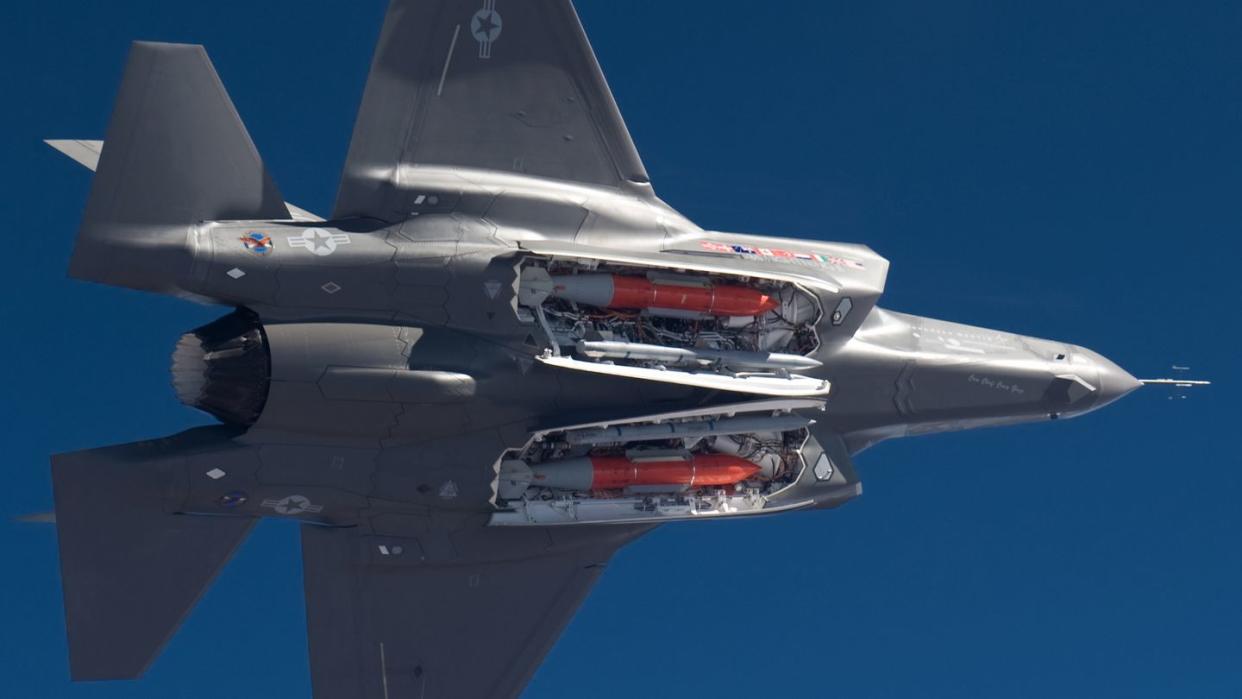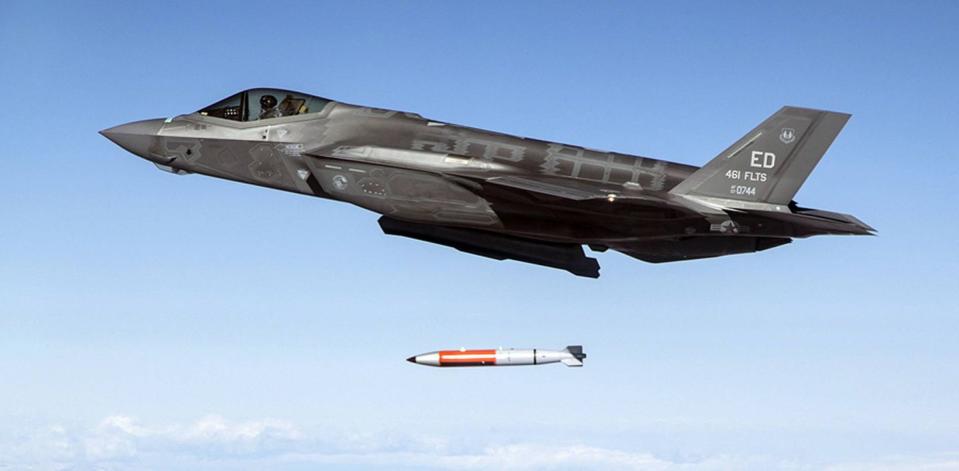The F-35 Is Now the World’s First Stealth Fighter Certified to Carry a Nuke

"Hearst Magazines and Yahoo may earn commission or revenue on some items through these links."
The U.S. Air Force’s F-35A Lightning II stealth fighters are now certified for delivery of B61-12 nuclear gravity bombs—and, in fact, have been since October 12, 2023.
This bombshell—dropped by F-35’s Joint Program Office (JPO)—was reported by Breaking Defense Friday morning. JPO spokesman Russ Goemaere stated that the certification had actually been awarded months earlier and far ahead of schedule.
This means that F-35As will now be considered “dual-capable” platforms useable in both conventional and nuclear warfare—in the latter role carrying up to two B61-12s internally and using its suite of ground-scanning sensors and datalinks to target the bomb more precisely than other B61-delivering aircraft.
Furthermore, while the U.S. Air Force has long operated conventional F-15E and F-16 fighters with the necessary ‘N-wiring’ to employ nuclear weapons, the F-35A is the first ever stealth fighter equipped as such.
Unlike the Air Force’s older air-to-air combat-oriented F-22 Raptor stealth fighter, the F-35A was always intended to assume the tactical nuclear strike capability of the F-16 fighters it was meant to replace. However, implementation of that capability—with the requisite wiring and datalinks to use the advanced features of the new B61-12 nuclear gravity bomb—was associated with an extensive (and highly expensive) upgrade program known as Block 4.
The certification award means that development and testing of the B61-12 capability is finally complete and deemed satisfactory after “10+ years of intense effort,” according to Goemaere.
Furthermore, the Air Force has stated that nuclear-capability is reportedly not dependent on receiving the full Block 4 upgrade package, and that the certification will be applied to “all” F-35As in the Air Force’s inventory. However, the F-35 isn’t certified for older B61-3 or B61-4 non-strategic bombs being replaced by the B61-12.

Now the Air Force has a much more survivable way to deliver its arsenal of tactical nuclear gravity bombs, thanks to the F-35’s ability to penetrate enemy airspace at lower risk of being detected in advance and coming under effective fire from ground-based air defense missiles. The F-35 is also only the second fighter (following the F-15E) to be specifically compatible with the B61-12, which has much greater precision and range than its predecessors (see below.)
While stealth is not strictly impenetrable—there are tactics to combat stealth fighters—a stealth fighter has dramatically greater odds of both reaching its target to deliver a gravity bomb and making it back to base than a non-stealth fighter, which will assuredly be detected from much further away (unless enemy radars have already been thoroughly suppressed).
The Air Force already operates the B-2, a long-range nuclear-capable stealth bomber that began operational use of the B61-12 in December 2023. It is also rapidly moving forward with production of its successor the B-21 Raider, which first took flight last November. Furthermore, the service formerly operated F-117 Nighthawk jets capable of dropping B61 nukes. But the F-117 was never actually a fighter, despite the ‘F’ in its designation, as it could only drop bombs and had no air-to-air capability whatsoever.
Lastly, Popular Mechanics previously reported on possible hints China may be studying a nuclear attack capability for its J-20 stealth fighters. Past speculation that Russia’s Su-57 stealth fighter could serve in a nuclear role has yet to be substantiated, and seems unlikely at present, given the type’s very limited production and operational usage to date.
It’s also worth noting that the U.S. shares roughly 100 B61 tactical nuclear bombs with NATO allies Belgium, Germany, Italy, The Netherlands, and Turkey. And all but Turkey are adopting F-35As with the potential to deliver nuclear weapons, replacing their F-16 or Tornado jets in that role. However, that will be affected by the pace at which the older B61s in Europe are replaced with new B61-12s.
Nuclear arms control expert Hans Kristensen noted that a U.S. F-35 fighter wing based at Lakenheath in the United Kingdom is almost certainly to be equipped for B61-12 delivery, based on an accidentally posted contract for construction of shelter facilities in support of a ‘nuclear mission.’
The B61-12 and F-35 combo
The B61-12 is an expensive refurbishment of older B61s that dramatically improves their capability by introducing maneuvering tails fins, spin-stabilizing rockets and both inertial and GPS guidance. That transforms it into a glide bomb that’s both extremely precise and can fly up to an estimated 15 miles (if launched at maximum altitude).
In the video below of a B61-12 test, note how the bomb is stored in an internal bay so as not to disrupt the F-35’s stealth geometry. Also note the ignition of the spin-stabilizing rockets at the 29 second mark.
Improved precision makes it far more likely that a B61-12 will knock out a hardened nuclear weapons facility with one hit. And even its modest standoff range makes the weapon much more survivable for those carrying fighters on board to employ than a traditional gravity bomb. Those more traditional models are dropped directly over a target, which puts the aircraft at greater risk to air defenses and even to falling victim to the blast of its own nuke.
This is true for stealth fighters, which grow detectable to infrared sensors and even radars at short distances. Furthermore, stealth fighters will be able to more safely fly at higher altitudes to leverage the B61-12’s maximum possible glide range.
The B61’s blast can be dialed in for an explosive yield as low as.3 kilotons or as great as 50 kilotons. For comparison, the Little Boy nuclear bomb dropped on Hiroshima, Japan had a yield of 15 kilotons.
A higher-yield B61-13 with a blast dialable to 360 kilotons is under development and slated for limited production. It will combine the new features of the B61-12 with the earth-penetrating characteristics of the specialized B61-11 bunker-buster variant, but will be reserved for bombers and not be integrated into the F-35.
The U.S.’s 230 B61 tactical nukes are fewer in number than its long-range strategic nuclear missiles—and, being gravity bombs, they are not configured for easy and prompt standoff delivery, as compared to a cruise or ballistic missiles.
Even a limited use of nuclear weapons could have awful consequences. But fortunately, the post-World War II taboo against nuclear weapons use remains powerful, and any nuke—even supposedly ‘tactical’ ones—would likely only be employed as a last resort. The tactical arsenal’s role is primarily to deter other states from the use of their own tactical nukes under the (likely foolish) perception there are fewer risks of using them. Russia in particular has over 1,800 non-strategic nukes, and may see threatened or limited use of these weapons as a viable strategic option to stave off defeat.
While ‘tactical’ nukes sometimes refers to the concept of use against battlefield targets, that’s less likely to be how the U.S. Air Force would use them. Instead, they would most likely be employed against enemy nuclear or chemical weapons facilities and associated command-and-control systems in retaliation for a nuclear attack, or (more controversially) in preemption of an imminent one.
Even then, as the U.S. already has non-nuclear bunker-buster weapons effective against hardened weapons facilities, nukes might only be resorted to when facing an extensive number of possible WMD launchers that could not be suppressed fast enough using conventional strikes.
The F-35’s nuclear capability had aroused complaints by local groups opposing new F-35 bases, particularly in Vermont, on the basis they will influence the nuclear targeting plans of Russia and China. There’s a layer of ambiguity, as the Pentagon does not disclose which of its fighters squadrons are trained and equipped for nuclear delivery missions. However, one should bear in mind that there were already hundreds of nuclear-capable F-15 and F-16 non-stealth fighters dispersed in bases across the United States, so the F-35 does not present a novel risk in that regard.
You Might Also Like

